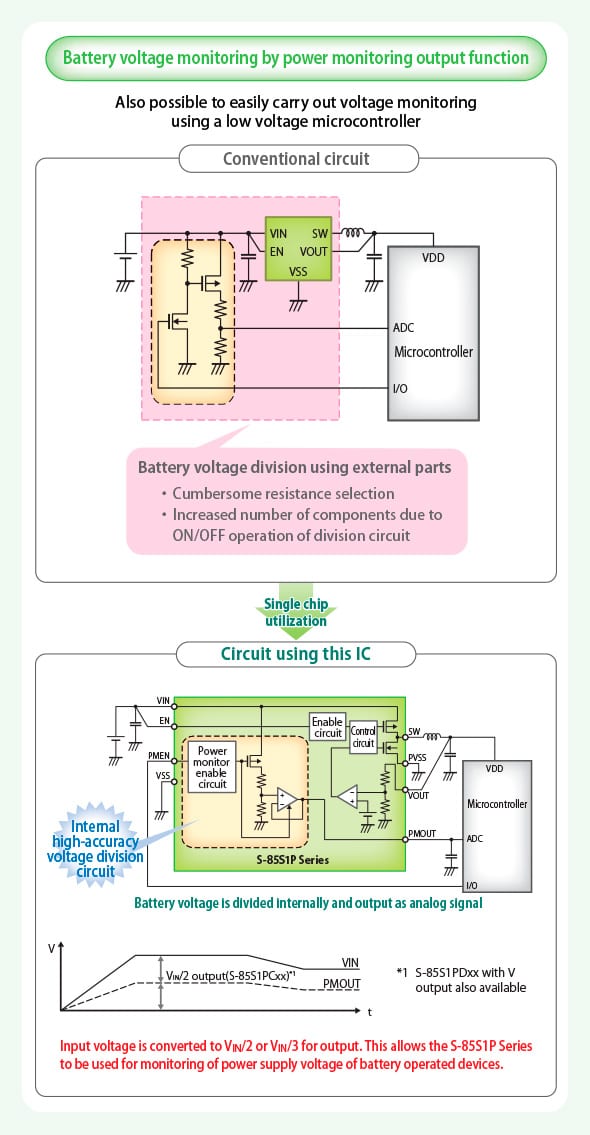Step-Down Regulator with Power Monitoring Function
SII Semiconductor's S-85S1P is an ultrahigh-efficiency step-down switching regulator for which a power monitoring function is added to its recently introduced S-85S1A Series. Like the S-85S1A, the S-85S1P features ultra-low self-current consumption, fast transient response, space saving package and enables an accurate understanding of the remaining battery life with its power monitoring function.
Along with the diffusion of mobile devices such as smartphones and tablets and now the expansion for the demand of IoT devices, the expectations for low power wireless modules such as Bluetooth Low Energy and LoRaWAN are increasing.
In general, BLE modules and LoRaWAN modules are required to operate for a sufficiently long time, even with a small battery. For BLE modules, a power monitoring function is required to accurately ascertain the remaining battery life.
When implementing a power monitoring function, because the self-current consumption has a negative impact on the running time of the battery for the entire module, the self-current consumption of the power monitoring needs to be extremely low.
Minimizing the self-current consumption of power monitoring while accurately detecting the remaining battery life ──
The company who requested a new solution from SII Semiconductor to resolve these two challenges is Braveridge Co., Ltd. Braveridge is a startup that develops and produces IoT devices as well as develops and manufactures low power wireless modules such as BLE/LoRaWAN.
To respond to the company's request, SII Semiconductor developed the S-85S1P, a step-down switching regulator that includes a power monitoring function. By adopting it, Braveridge succeeded in solving the two challenges it was facing.
In general, to understand the remaining battery life, a separate monitoring circuit is typically required.

However, this conventional method requires additional mounting space on the board because of the necessary external components. In addition, the accuracy is compromised. There is also the issue whereby the monitoring circuit on its own consumes power in order to ensure its accuracy.
The power monitoring feature within the S-85S1P divides the battery voltage input into fractions of half or one third. The S-85S1P then outputs and analog signal from the monitoring pin which can be input into the A/D converter terminal of the microcontroller.
The self-current consumption of the power monitoring circuit is reduced to 280nA and is not more than 540nA total including the self-current consumption of the step-down switching regulator. Because the power monitoring circuit can be disabled, it consumes only 260nA for the main circuit when it is not monitoring. This allows the battery consumption of the voltage monitoring to be minimized.
This power monitoring function can monitor the source voltage more accurately than existing circuits so it enables a precise understanding of the remaining battery life. It is possible to accurately predict the timing for replacing or charging the battery and to possible switch to an energy saving mode.
SNT-8 A The S-85S1P does not require an external power monitoring circuit and all elements are implemented in an ultra-small package, the SNT-8A. The SNT-8A dimensions are 2.46 x 1.97 x 0.5 mm, the industry's smallest class.
A The S-85S1P does not require an external power monitoring circuit and all elements are implemented in an ultra-small package, the SNT-8A. The SNT-8A dimensions are 2.46 x 1.97 x 0.5 mm, the industry's smallest class.
While it implements a power monitoring circuit, it achieves space savings close to the S-85S1A in the SNT-6A package; (1.8 x 1.57 x 0.5 mm; 6 terminals). In addition, a variety of protection circuits are integrated as in the S-85S1A.






